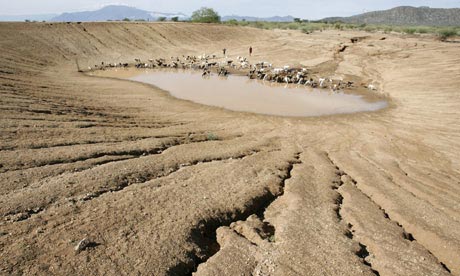Leaked UN report shows cuts offered at Copenhagen would lead to 3C rise
UN secretariat initial draft shows gap of up to 4.2 gigatonnes of CO2 between present pledges and cuts required to limit rise to 2C
Read the UN analysis document here
A confidential UN analysis obtained by the Guardian reveals that the emissions cuts offered so far at the Copenhagen climate change summit will lead to global temperatures rising by an average of 3C.
The analysis seriously undermines the statements by governments that they are aiming to limit emissions to a level ensuring no more than a 2C temperature rise over the next century, and indicates that the last 24 hours of negotiations will be extremely challenging.

Nomadic Turkana pastoralists at a dried out dam in Kenya. A rise of 3C would mean up to 170 million more people suffering severe coastal floods and 550 million more at risk of hunger, according to the Stern review. Photograph: Stephen Morrison/EPA
A rise of 3C would mean up to 170 million more people suffering severe coastal floods and 550 million more at risk of hunger, according to the 2006 Stern economic review of climate change for the UK government - as well as leaving up to 50% of species facing extinction. Even a rise of 2C would lead to sharp decline in tropical crop yields, more flooding and droughts.
The paper was drafted by the UN secretariat running the Copenhagen summit and is dated 11pm on Tuesday evening. It is marked "do not distribute" and "initial draft". It shows a gap of up to 4.2 gigatonnes of carbon emissions between the present pledges and the required level of 44Gt, which is required to staying below a 2C rise. No higher offers have since been made.
"Unless the remaining gap of around 1.9-4.2Gt is closed and Annexe 1 parties [countries] commit themselves to strong action before and after 2020, global emissions will remain on an unsustainable pathway that could lead to concentrations equal or above 550 parts per million, with the related temperature rise around 3C," it says.
The goal of keeping the increase in global average temperatures below 2C, relative to pre-industrial levels, has become the figure that all rich countries have committed to trying to achieve in Copenhagen.
However, 102 of the world's poorest countries are holding out for emission cuts that would result in a temperature increase of no more than 1.5C. Anything below that, they say, would leave billions of people in the world homeless, unable to feed their people and open to catastrophic weather-related disasters.
"Further steps are possible and necessary to fill the gap. This could be done by increasing the aggregated emission reductions to at least 30% below the baseline levels, further stronger voluntary actions by developing countries to reduce their emissions by at least 20% below business as usual and; reducing further emissions from deforestation and international aviation and marine shipping," says the internal paper.
Greenpeace campaigner Joss Garman said: "This is an explosive document that shows the numbers on the table at the moment would lead to nothing less than climate breakdown and an extraordinarily dangerous situation for humanity. The UN is admitting in private that the pledges made by world leaders would lead to a 3C rise in temperatures. The science shows that could lead to the collapse of the Amazon rainforest, crippling water shortages across South America and Australia and the near-extinction of tropical coral reefs, and that's just the start of it."
The talks remained on a knife edge on Thursday, with world leaders meeting for the first time this evening at a dinner hosted by the Queen of Denmark. One great obstacle - the fate of the Kyoto treaty - was solved today with China and the developing world seeing off attempts to kill the protocol. But the row caused much time to be lost and whether enough time remains to salvage a strong deal is still in question.
The biggest remaining obstacles that remain are who pays for the fight against climate change and how much, emissions cuts and how promises of cuts are verified. Earlier, US secretary of state, Hillary Clinton, pushed the negotiations forward by committing the US to contribute to a $100bn (£62bn) a year fund from 2020. Indonesia today followed China's lead in softening its opposition to international monitoring of carbon cuts.
Earlier this week, Rajendra Pachauri, who heads the UN's Intergovernmental Panel on Climate Change (IPCC), told the Guardian that even with 1.5C rises, many communities would suffer. "Some of the most vulnerable regions in the world will be worst affected. These will be the largest countries in the developing world. They have little infrastructure that might protect them from climate change. The tragedy of the situation is that those countries that have not at all contributed to the problem of climate change will be the ones that are most affected," he said.
"Some parts of the world, which even with a 1.5C rise, will suffer great hardship and lose their ability to lead a decent and stable form of existence. If we are going to be concerned about these communities, then maybe 1.5C is what we should be targeting. But if we can find means by which those communities can be helped to withstand the impact of climate change with substantial flow of finances, then maybe one can go to 2C.

No comments:
Post a Comment